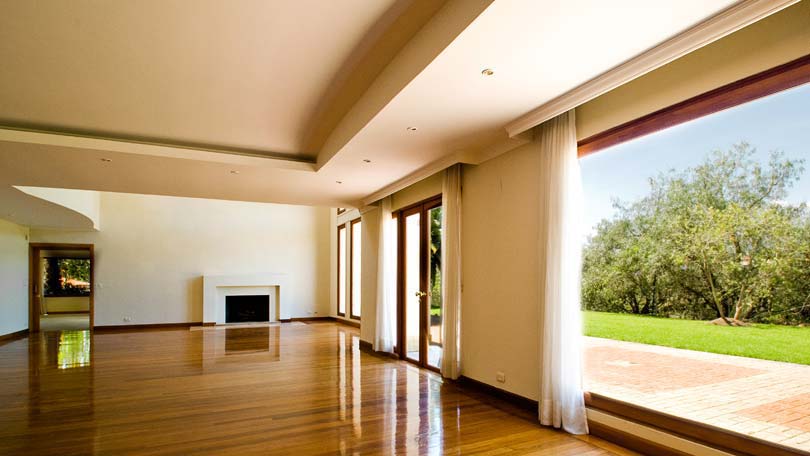
There are a number of things that need to be considered when buying hardwood flooring, ranging from what type of room you want it to go into, to your budget and style choices.
What type of room is the floor going in?
Hardwood flooring is very versatile and can be fitted in almost any room in your house. However, if a room fluctuates in temperature or humidity, for example: kitchens because of steam from cooking and the oven temperature; utility rooms because of the washing machine and tumble dryer; conservatories or rooms with large amount of glazing because of fluctuating temperatures; rooms with log burners because of the heat and dry air; then engineered wood flooring must be used. This is because engineered wood flooring planks are made up of multiple layers, meaning they are dimensionally stable and can withstand fluctuations in temperature and humidity levels. In any other type of room (where temperature and humidity does not fluctuate) either solid wood flooring or engineered wood flooring can be used.
The only room hardwood flooring should not be used in is a bathroom as it is inevitable that a water will be splashed and dripped on the floor on a regular basis. This can cause the hardwood floor to warp and swell. It is recommended that vinyl or ceramic tiles are used in bathrooms.
Do you have under floor heating?
If you have under floor heating then engineered wood flooring must be used. Because engineered wood flooring planks are made up of multiple layers they are dimensionally stable so will not expand and contract with temperature change, like solid wood flooring planks.
What is your budget?
Prices of hardwood flooring vary significantly due to the size of the board and species of wood. Generally, the wider and longer the hardwood flooring plank, the more expensive it becomes. The thickness of the plank can also affect price, with a thicker plank being more expensive. Prices also vary depending of the rarity of the species of wood. For example, Oak flooring is reasonably priced because it is a common wood to use for flooring, whereas Walnut flooring, which is far rarer, is more expensive.
What type of subflooring do you have?
The subfloor is the existing floor in your property. The main types of subfloor are: joists, concrete, wooden floor boards, plywood, chipboard, asphalt and bitumen. Before installing any hardwood flooring, ensure that the subfloor is flat, level and dry. Installation methods for solid wood flooring and engineered wood flooring differ depending on the subfloor. The correct method of installation should be checked before the floor is fitted.
What traffic is expected in the area?
The location and usage of the room where the hardwood flooring will be laid will determine how hard you require the floor to be. Different species of wood have different levels of hardness. For example, Jatoba flooring is one of the hardest available, but it is rare and expensive. Oak flooring has a medium hardness, whereas Walnut flooring is much softer than Oak flooring and can dent very easily so should not be used in high traffic areas. A more recent product, strand woven bamboo flooring is very durable and is two and a half times harder than Oak flooring.
What style and colour of flooring do you want?
Style and colour choice depends on personal preference. Different species of wood have different colours and patterns, and as wood is a natural product, shades and grain patterns will vary. There are a wide range of hardwood floors available with Oak flooring offering a classic wooden floor look, and Walnut flooring giving a more marbled effect. Hardwood flooring is also available in different widths and lengths, to suit preference. Widths of hardwood flooring planks range from 63mm – 400mm, and lengths are either fixed or random.
What finish are you looking for?
Hardwood flooring is usually available in four main finishes to suit personal preference: lacquered, oiled, brushed and oiled, and unfinished.
A lacquered finish, which is available in either a matt or semi-matt appearance, offers a smooth effect which makes cleaning the floor easy. Scratches to the floor may be evident but this can be avoided if care is taken.
An oiled finish has a slightly rough feel to offer a more natural appearance to the floor. Scratches are less evident and cleaning is easy.
A brushed and oiled finish has a more textured feel to offer a more authentic appearance. Like the oiled finish, scratches are less evident and cleaning is easy.
An unfinished floor is the raw material. A stain of choice can be added and the floor must be sealed with either a lacquer or oil to provide protection against dirt and water spills.
Article By: Chris Elliot
Chris Elliot has been involved in the solid wood flooring industry for over a decade and is currently serving as Managing Director of Ambience hard wood flooring in Leicester, United Kingdom.
